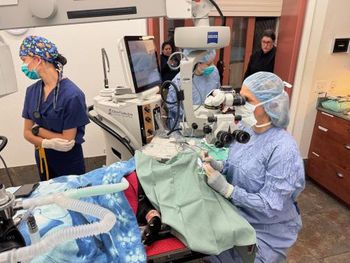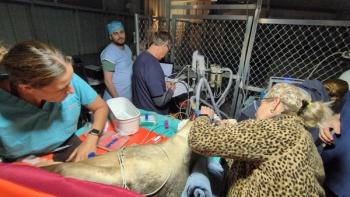
The role of the technician in an ocular examination (Proceedings)
The role of a veterinary technician is key in identifying and diagnosing ocular disease in veterinary patients. Often, this happens before the patient even steps into the hospital, when the owner calls to make an appointment.
The role of a veterinary technician is key in identifying and diagnosing ocular disease in veterinary patients. Often, this happens before the patient even steps into the hospital, when the owner calls to make an appointment. Eye problems can be extremely tricky to evaluate over the phone and determine the severity based on what the owner is describing. In general, any sudden changes in the appearance (in or around the eye) or visual function of the eye should be seen as soon as possible. Some disease processes can progress rapidly, even over a matter of hours, to a critical state and catching things as early as possible gives us a better chance to prevent permanent damage or minimize scarring.
Sometimes the age or breed of the pet can give clues as to what may be going on and how risky waiting to be seen can be. As you know, animals try to hide weakness and pain and will often not show ocular discomfort in a way the owner recognizes as pain. Commonly, less serious problems will actually be more painful or obvious to an owner than the signs of a more serious condition.
When consulting with the owner about the appointment, make sure you instruct them to bring anything that they have used in or around the eye with them to the appointment, and any medications they may have from another doctor or a different pet. If they can't be seen right away, be sure to provide them with emergency options and, especially for problems such as corneal disease, instructing them to place an Elizabethan collar on their pet to prevent additional self-trauma until they can be seen, can make a big difference.
Once you have the patient there for examination, you need to concisely weed through the history to determine what is pertinent to the eye problem. Having previous treatments in hand can facilitate this, letting you then focus on information such as:
· Which eye currently has the problem, and when did they first notice any change?
· Have they seen discharge, squinting, redness, swelling, or noticed the pet pawing or rubbing at the eye?
· Has either eye ever had any problem in the past (same complaint or even different issue)? If so, which eye and how long ago?
· If they have used anything to treat the eye – what did they use and when was it last administered?
· Have they noticed any other changes in the overall health or behavior of their pet? Do they think they are having trouble seeing?
· What other health conditions has their pet previously been diagnosed with and are they on any other medications other than for the eye? Any other supplements the owner is giving them?
· Travel history or other areas the dog has lived in or visited?
If you would like more information, a detailed form containing the history we ask owners to provide initially can be found on our website at www.eyecareforanimals.com.
Now that you have them there and ready go to, have a plan with your doctor to determine if they want you to perform any testing prior to them examining the patient. Most of our patients coming in on referral, unless there is concern about the integrity of the eye, will have a Schirmer tear test and tonometry (to measure the intraocular pressure) performed by our technicians even before the doctor's exam, but this should be determined by you and your veterinarian for what is best in your situation and for your comfort level.
An eye exam is best done in low lighting conditions or in the dark, in a quiet area so try to find an examination area that will best accommodate this. Small dogs (or short legged dogs) should be placed on a table and having cats restrained in a “kitty burrito”, with the cat's body is wrapped in a towel, can make things go much easier when you are trying to control them in the dark.
It is crucial that the animal remain still and facing forward during the examination. Animals with fragile corneas must be handled tenderly to decrease the chances of causing a rupture or re-rupture and you should never use any more force than is absolutely necessary. There can be a dramatic affect on intraocular pressure measurement based on the position of the body, neck, and force used to restrain the animal (especially brachycephalics where you are probably pressing directly on the eye just by pulling back the eyelids). The head should be stabilized with one hand under the mandible supporting the jaw without putting pressure on the neck, and the other behind the head to prevent shaking or recoiling. The body can be gently supported to decrease the ability for the animal to twist around in your arms.
Most animals are surprisingly compliant for an eye exam under the right conditions. If there is ever a question, we will place a muzzle just because the veterinarians face will be right up at the dog's nose, but rarely do they need sedation. Sedation can also interfere with your testing so it is best to avoid it whenever possible. Rarely, we will have to sacrifice accurate testing for animals that are too painful or aggressive to be examined awake.
At the end of the examination, be sure to review which medications go in which eye and how to apply them. Owners may confuse their left and right eye with their pets left and right eye and using “good eye” and “bad eye” doesn't always work if something different is going on in each eye. Demonstrating ways to restrain their pet at home and administer drops or ointments will aid immensely with their compliance. Helping to reinforce the importance of the medications that are being prescribed will also support your doctor's instructions and have available reliable resources to give the owners if they need more information on the drugs or diagnosis.
Eye problems are a scary and foreign thing for many owners and you can assist them, as well as your veterinarian before, during and after the examination to help bring about the best possible outcome.
Newsletter
From exam room tips to practice management insights, get trusted veterinary news delivered straight to your inbox—subscribe to dvm360.




